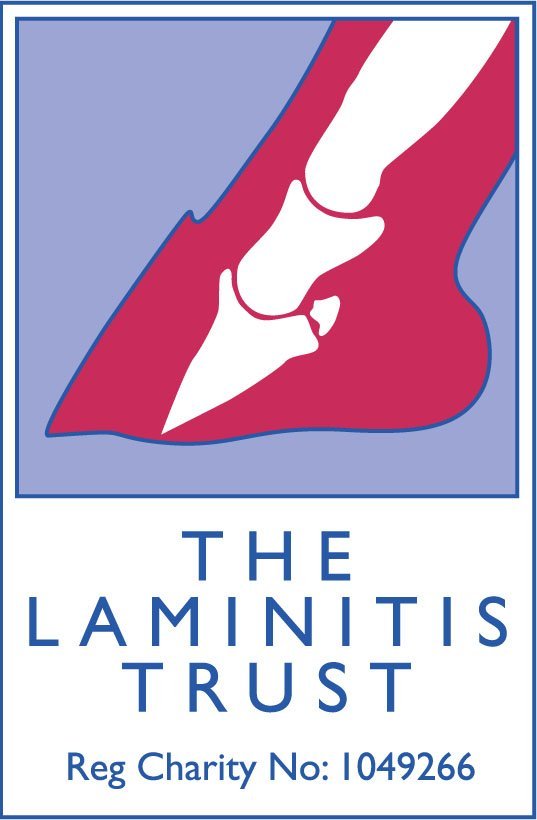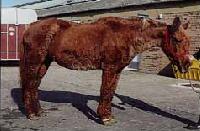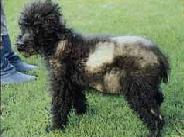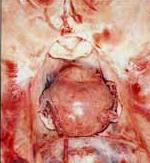 |
EQUINE
CUSHING'S DISEASE
by Robert A Eustace FRCVS Abstracted from the scrutineered veterinary journal In Practice (1991) Vol 13. No 4 July p 147-148 |
|
|
|||||||||||||||
|
Despite demonstrating obvious abnormalities of clinical appearance, both the dog and the pony (Plates 1 & 2) are suffering from the same condition; Cushing's Syndrome (hyperadrenocorticism). Hyperadrenocorticism produces the opposite changes in hair coat in the two species. In equines this condition is usually secondary to an adenoma, or hyperplasia, of the pars intermedia of the pituitary gland whereas in the dog the syndrome may be primarily of adrenal origin. In horses there appears to be insufficient DOPamine being released from the hypothalamus. DOPamine inhibits the pars intermedia of the pituitary gland. Therefore when there is less DOPamine there is less inhibition of the pars intermedia which then increases in size. Equine Cushing's cases always develop laminitis if they live long enough. They may become immunosuppressed and subject to a variety of parasitic or infectious agents such as helminthiasis or pneumonia. Many cases show muscle loss and become polydipsic and polyphagic; they may be diabetic. A supra-orbital swelling, due to the deposition of a fat depot, is commonly seen giving the eyes a protuberant appearance. To the trained observer, these cases can be diagnosed on clinical appearance and history alone. The clinical signs include; Failure to shed their coat in Spring, the coat becomes long, thick and matted. Affected animals tend to sweat more than normal, they lose weight despite an increased appetite. They may become diabetic, either diabetes mellitus, (sugar diabetes) or diabetes insipidus. They therefore drink excessively, and if stabled you will notice their bedding is quickly soaked. They show filling above the eyes. This is fat deposition in the supra-orbital fossae. [Normal horses have depressions above the eyes, you can see these depressions moving when a horse chews]. They become depressed and ill-looking, with dull eyes and they lose the shine on their coat. They all develop laminitis eventually. Their body shape changes so that they lose muscle mass, developing a dipped back, poorly muscled neck and quarters with a pendulous abdomen. There is a re-distribution of fat depots. The horse looking thin ("ribby") but gaining a rather "blocky" appearance. This is particularly evident if it has been dieted in the mistaken belief that it's laminitis is due to obesity. Their resistance to infections or worm burdens is reduced. |
|||||||||||||||
 |
Cushing's syndrome produces opposite changes in hair coat in the horse and dog. |
||||||||||||||
 |
|||||||||||||||
|
Cut surface of the pituitary gland above after sagittal sectioning to show the neoplasm |
|||||||||||||||
|
|
|||||||||||||||
|
Enlarged equine pituitary gland left in the cranium following rupture if the infundibulum during removal of the brain. |
|||||||||||||||
|
Confirmatory tests The test regime I am using now is to measure endogenous ACTH, cortisol, insulin and glucose from venous blood samples at 0900 hours before the morning feed and in a quiet environment. This is a simple test to use, although the blood cells have to be separated from the plasma and the sample kept frozen prior to testing. This test does not run the risk of inducing or worsening laminitis following the administration of a corticosteroid. It will differentiate between pituitary dependent Cushing's cases and those animals with obesity related laminitis. Treatments for Pituitary dependent Cushing's disease In some animals the pituitary pathology seems to result in little disability other than the change in the haircoat. In other more advanced cases recurrent episodes of laminitis result or the animal may eventually succumb to an overwhelming systemic infection. However many cases showing the classical changes in the hair coat can live happily for years before they become laminitic, diabetic or begin to lose condition. Even if the animal has suffered laminitis but in other respects appears well, these cases can be greatly improved by correct foot dressing and/or shoeing. The precise prevalence of pituitary dependent Cushing's disease is unknown but it is probably quite common in elderly individuals. The youngest case I have seen was 8 years old. If you only realise that your horse has pituitary dependent Cushing's disease when it gets an attack of laminitis, then the outlook can be grave. In some cases the normal laminitis treatments of acepromazine and phenylbutazone are not "strong" enough to correct the vasoconstriction in the feet. In these cases I have used phenoxybenzamine drips, over 48 hours, successfully. The horse should really be hospitalised if this is to be undertaken. The long term prognosis for Cushing's Disease cases if bad, if they also have chronic founder then this worsens the prognosis. However there are a couple of drugs which have proved valuable for treatment. The treatment does not cure the change in the pituitary gland but reduces the amount of the hormones which are released from it. These treatments can give horses a good quality of life for 2 years or more. Although the treatments are recommended for year round medication we have found that in many cases treatment can be tailed off then stopped in the Spring and started again in the Autumn. This is because the pituitary gland receives information from the pineal gland (the third eye) indicating the day length. Most horses with Cushing's Disease come down with laminitis in the Autumn, as day length shortens, and in the Winter. If Cushing's Disease laminitis cases are left untreated they cannot self cure and suffer laminitis continually. Some temporary improvement in the clinical condition of about 80% of cases has resulted following treatment with cyproheptadine (Periactin). However, at best this results in a temporary improvement in the clinical condition of the animal. No treatment has a curative effect. Periactin. Small white tablets (4mg Cyproheptadine) Effective in about 80% of cases. Relatively inexpensive.. |
||
|
Periactin dosage for a 300 kg Pony. 4 mg tablets. Dose rate 0.6 mg/kg/day 3/4 |
||
|
||||||||||||||||||||||||||
|
Thereafter
20/day. Periactin
dosage for a 400 kg Pony. |
||
| ||||||||||||||||||||||||||
|
Thereafter 26/day. |
||
|
Periactin dosage for a 500 kg Pony. 4 mg tablets. Dose rate 0.6 mg/kg/day 3/4 | ||
| ||||||||||||||||||||||||||
|
Thereafter 31/day. | ||
|
Prascend (Pergolide 1mg pink tablets) The drug is expensive so if you use it make sure the horse eats it ! The surest way is to feed it from the hand either in a titbit or a sandwich. Potential adverse reactions in horses include inappetance, transient anorexia and lethargy, mild central nervous system signs (e.g. mild depression and mild ataxia), diarrhoea and colic! Dosage 2 microgrammes per kg bodyweight daily as a continuing treatment. This drug is much more expensive than Periactin but seems a little more reliable in achieving a positive response. Trilostane (120mg capsules) This drug is being trialled by Cathy McGowan of the Royal Veterinary College, London. Her preliminary findings are posted on this site. For further information ask your veterinary surgeon to contact Dr McGowan. Vitex trial The Laminitis Trust has conducted a trial using an extract of the plant Monkspepper or Chasteberry (Vitex agnus castus). This herbal extract has shown to be effective in controlling the effects of Cushing's disease in horses. Click here for further information on this trial. Obesity related laminitis I have encouraged all horse owners over the last 10 years not to allow their horses to become obese, as this puts them at high risk of laminitis. Although we are not sure exactly why this occurs, we do know that many fat horses show insulin resistance, in other words they do not show a lowering of blood sugar concentrations when injected with insulin. Recently, Dr Johnson in the US has suggested a possible explanation. He has suggested that fat horses and ponies may be suffering from a syndrome which has been well recognised in humans, that of Omental Cushing's disease. In humans, the omentum, a fatty sheet which covers the intestines, becomes an abnormal site for the production of the hormone cortisol. The omentum in these individuals contains an aberrant set of enzymes which convert the person's own inactive cortisone into the active form cortisol. This increased amount of circulating cortisol has an adverse effect on the horse's carbohydrate metabolism causing an increased blood glucose and insulin. A similar situation may be occurring in fat horses which show high concentrations of circulating, cortisol, insulin and glucose, are hard to diet and often suffer from laminitis. This syndrome in horses is sometimes referred to as Peripheral Cushing's disease though I think this is not a very good name as the extra cortisol is not coming from the adrenal gland. Omental Cushing's Disease, Peripheral Cushing's Disease and insulin resistance all mean the same thing when relating to equids. The new test we
are using, measuring endogenous ACTH, cortisol, insulin and glucose
can differentiate pituitary dependent Cushing's cases from obesity related
laminitis. References. Eiler,
H., Oliver, J. and Goble, D. (1979) Beech,
J. and Garcia, M.C. (1985) Garcia,
M.C. and Beech, J. (1986) NOAH Compendium of Data
Sheets for animal medicines (2013) |
||

